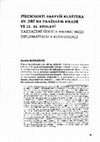Papers by Renata Modráková
Acta Musei nationalis Pragae. Historia litterarum, 2018
Acta Musei nationalis Pragae. Historia litterarum, 2019
Acta Musei nationalis Pragae. Historia litterarum, Nov 1, 2019
Acta Musei Nationalis Pragae – Historia litterarum, 2017
Zpracování rukopisných zlomků má v českých zemích jistou tradici. Knihovna Národního muzea v posl... more Zpracování rukopisných zlomků má v českých zemích jistou tradici. Knihovna Národního muzea v poslední době představila několik výjimečně kvalitních prací, věnujících se bezprostředně této tématice. V této anotaci se budeme věnovat chronologicky nejstaršímu svazku, věnovanému sbírkám Adolfa Patery a Čeňka Zíbrta a editovanému M. Dragounem a J. Markem. Rukopisné a tištěné fragmenty tvoří nedílnou součást každé knihovny. Až na jisté výjimky můžeme konstatovat, že čím větší knihovna, tím větší má fundus rukopisných zlomků. Fenomén rukopisných zlomků byl zkoumán v četných samostatných studiích 1 a kompendiích 2 a stal se sám o sobě námětem četných konferencí. 3
Acta Musei nationalis Pragae. Historia litterarum, 2020
The libraries of Bohemian female monasteries were distinctive units with thematically diverse cod... more The libraries of Bohemian female monasteries were distinctive units with thematically diverse codices in both manuscript and printed form. This article focuses on their composition and possible transformation in the Post-Hussite period with an overlap to the 16th century. Five important nunneries of various orders have been chosen as models.
The virtual exhibition “…and the Word became Music” invites you to the world of books made many c... more The virtual exhibition “…and the Word became Music” invites you to the world of books made many centuries ago to record the musical ideas of the people of that era. And music is what connects us with the world of our ancestors living during the Middle Ages and the early modern period. While preparing the virtual exhibition, we were working with manuscripts that have been digitalized in the Manuscriptorium virtual library, available musical editions, and recordings of music. In some cases, the..
Acta Musei Nationalis Pragae – Historia litterarum, 2018
An International Workshop proposed by the Center for Ibero-American Studies of the Faculty of Art... more An International Workshop proposed by the Center for Ibero-American Studies of the Faculty of Arts, Charles University (SIAS FF UK), the French Institute for Research in Social Sciences (CEFRES), the Institute of Art History of Czech Academy of Sciencies (ÚDU AV ČR) and the University of Valladolid. Time & Venue: 25(-26) September 2017, Prague, Czech Republic https://transmissions.ff.cuni.cz/en/ The aim of the workshop is to set into focus the monastic space as a multifaceted research theme f..
1st ed. Vydáno u příležitosti výstavy Čechy - křižovatka Evropy konané v Galerii Klementinum Přel... more 1st ed. Vydáno u příležitosti výstavy Čechy - křižovatka Evropy konané v Galerii Klementinum Přeloženo z češtiny
The short form of Curriculum Vitae

The Rule of Saint Benedict prohibited the monks and nuns from owning private property, including ... more The Rule of Saint Benedict prohibited the monks and nuns from owning private property, including manuscripts and stationery. However, this part of the Rule was often disobeyed in medieval monasteries. This fact is prominent in the St. George's Cloister at Prague Castle, where a larger number of medieval manuscripts were placed. Nowadays, these manuscripts are deposited in the Department of Manuscripts and Printed Books in The National Library of the Czech Republic. This Cloister was a wealthy and powerful ecclesiastical institution in the medieval Czech countries. Also, it was the exclusive educational centre for girls and women of influential aristocratic families, including Přemysliden. They were used to living in luxury and were not willing to live in unsatisfactory conditions. We determine three groups of these medieval manuscripts. The first of them are manuscripts ordered and written for the St. George convent. The majority of them were liturgical texts. The rest were works of famous ecclesiastical fathers. The second group presents manuscripts ordered by nuns or their families. They were often prepared in a pure form as it wasn't always clear if the girl was really going to enter the Cloister, so the manuscripts were later adjusted according to conventions of St. George's Cloister. The nuns used this type of manuscripts during their lives in the Cloister and after their death, the manuscripts were incorporated into the library or loaned to other sisters. It is possible to find many personal notices in the manuscripts belonging to the second part. The most interesting group of St. George's manuscripts is the third one. It was nuns and especially abbesses, who ordered these manuscripts (breviaries, praeces and texts with mystical theme). Its contents were compiled according to their ideas and knowledge, the codices were written and depicted according to their requirements. Every single manuscript from this small part reflects its proprietress, her cultural niveau and level of knowledge. Of course, the second and the third group of manuscripts were inconsistent with the Rule. But the understanding of personal property in the Middle age was a bit different from our contemporary view. In fact, what we understand as a conflict, wasn't perceived as such by medieval people.

Relationships between St. George’s abbey and the Court express the term “bipolar” very well. Firs... more Relationships between St. George’s abbey and the Court express the term “bipolar” very well. First relationship was created in the time of a foundation, i. e. in the second half of the 10th century. The foundation was controlled by the politics of the Bohemian prince (Boleslav I). and his son (Boleslav II.). The first abbess, the Přemyslid Mlada (Marie), daughter of Boleslav I., played an important role and formed positions of St. George’s abbesses during whole Middle Ages. Other important factor was the St. George’s abbey position in the heart of the Prague Castle, the centre of Bohemian Princedom and Kingdom. At least, it is necessary to have in mind a primary function of this monastery as an early burial ground of Pře¬myslid house. The author studies various types of historical documents and defines three main of them. First, necrological notices in some manuscripts of St. George’s library contain in some cases Přemyslid names, also names of persons with con-nections to the monastery or abbesses. Second, the collection of St. George’s abbey manuscripts reflects fashionable and modem impacts of Bohemian court very often (for example the so called Passionale of the Abbess Cunigunde from the 20'h of 14. C.) Third, a collection of St. George’s abbey charters emphasizes the sovereign and self-confident situation of the presented Monastery. At the end, the author presents some examples of the St. George’s abbey treasure (for example a pre-gothic frontispiece, a bust of St. Ludmila from the 14th C. etc.) The St. George’s abbey figured as the advanced cultural institution with many links and reflects to the Court of Bohemian Princedom and Kingdom.

Written materiál of monastic institutions stays to be a constant of the themes studied by histori... more Written materiál of monastic institutions stays to be a constant of the themes studied by historical Sciences. However, the issue of female monasteries stays to be among them a “Cinderella”. Many of them were ranged among the most im- portant Bohemian monasteries, such as the presented monastery of Benedictine of St. George at the Prague Castle (see its position of the oldest monastery of Czech countries). There are certain specifications, given by many facts, for example the origin of nuns (abbesses and nuns often came from a ruling family or from high Bohemian aristocracy); by keeping family relations; large economic possibilities of the monastery and the placement near royal court. It works with documents as well as with manuscripts from i3th to early isth century (or until the beginning of Hus- site movement). The time period is given by the specific development of St. Ceorge Monastery at that era. Iťs necessary to mention that these documents were hrst made outside the monastery (from the rádius of Vyšehraďs canons), from the end of the 13* century, Services inside were ušed (maybe the canons of St. George monastery, connected with assumpted activities of scriptorium of St. Geor¬ge Monastery) and from the half of the i4th century, Services of public notaries were fmally ušed. The examined documents were connected with an uncommonly extensive production of manuscripts in this particular time. There are, apparently, connections to documents’ production in some cases (námely manuscripts NK ČR XIII.E.i4e, VI.C.16b, XIII. A.2), but direct writeťs agreements were not proved, of course. Both groups prove some elimination and penetration into the strictly de- fined historical frontiers - which is typical for observed materiál. There is a men¬tion of seals that belonged to the abbesses of St. Ceorge monastery in connection with an effort to prove the sovereign position of St. Ceorge Monastery. There is an interesting contradiction between manuscripts’ care (and a fully functioning bib- liotheca) and documents (lower care of its preservation). The St. Ceorge monastery canons’ situation was left apart because it requires a separate study. Definitely, results show the high niveau of written culture and tradition in the monastery and sovereign position of the abbesses and the whole convent as well as the effort to prove the existence of the scriptorium in this monastery.

Not until the usage of new, contemporary technologies was it clear that the situation among the i... more Not until the usage of new, contemporary technologies was it clear that the situation among the individual convents was not very different. As we click through the individual folia, it is clear how many similarities between them there are despite the distance of their places of deposition today across the entire world. The shared circles of the individual genres, development of the language, textual and pictorial parts and tendencies surface strikingly. And only this complex view can in reality bring something new. Now, a look into only one limited area is completely insufficient. Only the correct restoration of the manuscripts to their original milieux, to the places where they were really created while observing certain trends that were substantial and decisive for their period can leave them enough room to say something more about themselves than what their folia can offer in a physical touch.
The National Library of the Czech Republic deposits a collection of manuscripts closed to the so ... more The National Library of the Czech Republic deposits a collection of manuscripts closed to the so called Czech Reformation. These manuscripts reflect a very interesting movement which influenced the Reformation Movement in German. In 2006, this collection have been written to the UNESCO Memory of the World Register.
1st ed. "The publication was issued on the occasion of the homonymous exibition which took p... more 1st ed. "The publication was issued on the occasion of the homonymous exibition which took place at the Klementinum Gallery"--Rub tit. s. Přeloženo z češtiny Terminologický slovník
1. vyd. "Publikace vyšla u příležitosti stejnojmenné výstavy konané v Galerii Klementinum&qu... more 1. vyd. "Publikace vyšla u příležitosti stejnojmenné výstavy konané v Galerii Klementinum"--Rub tit. l. Terminologický slovník
1. vyd. Vydáno u příležitosti výstavy Čechy - křižovatka Evropy konané v Galerii Klementinum











Uploads
Papers by Renata Modráková
Klášter benediktinek u sv. Jiří na Pražském hradě je nejstarším v Čechách vzniklým klášterem. Patřil mezi nejvýznamnější a nejbohatší církevní instituce v českých zemích. Z původní klášterní knihovny se dochovalo vice jak sedmdesát rukopisů. Obvyklý repertoár tvoří liturgika. Ve dvaceti rukopisech byly vevázány různě staré kalendáře (vesměs z 13.-14. století). Cílem diplomové práce, ukončené v roce 2004, bylo podrobně prozkoumat nekrologické přípisky, vpisované od písařů a příležitostně též sester, do uvedených kalendářů. Podařilo se postupně identifikovat jednotlivé písařské ruce. V mnohých případech bylo uvedené jméno ztotožněno s konkrétní osobu sestry, kanovníka, zakladatele či “dobrodince” kláštera. Zároveň byly značně rozšířeny dosud kusé dějiny tohoto kláštera. Součástí práce byly podrobné popisy jednotlivých nekrologických přípisů, písařských rukou a jednotlivých osobností písařů a připomínaných osob. Nedílnou součást tvoří podrobný a obsáhlý seznam pramenů a literatury.